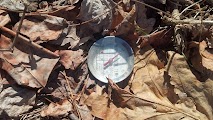An Evening with Woodcocks (Saturday March 16)
On Saturday evening about 20 of us had a wonderful time watching the woodcocks perform their timeless display in the fields behind the farmhouse. Our good friends, Michael Kieffer and Bull Run Conservancy members joined us for this annual event. It was a perfect evening with mild temperatures and a clear sky. For some, it was the first time witnessing this age old right of spring.
 |
| Source: Birds of North America Online http://bna.birds.cornell.edu |
following for half an hour. There were four males displaying in our immediate vicinity. Likely, they will continue to display at dawn and dusk for the next few weeks.
Last night (Monday) after plowing the road, I watched a male set up his singing ground in the open road, taking advantage of what seemed to be the only place to sing due to deep snow on the fields. He seemed surprised to immediately attract a female and quickly started to utter his "tuku"sound. He propped his wings up and forward and marched toward her twisting slightly back and forth as he approached. The curious female slowly moved away, only mildly interested, and commenced probing the snow cover as if looking for something to eat. This went on for a few minutes at which point the male abruptly gave up his pursuit, ran back to his preferred singing site and let out loud "peent" calls to try to attract a more suitable female. The female left the area, and soon the male was off on his "sky dance" once again.
 |
| wrapping up after seeing the display |











